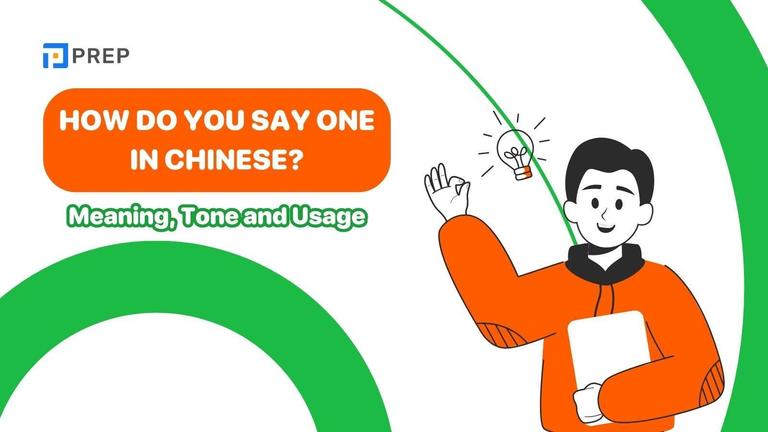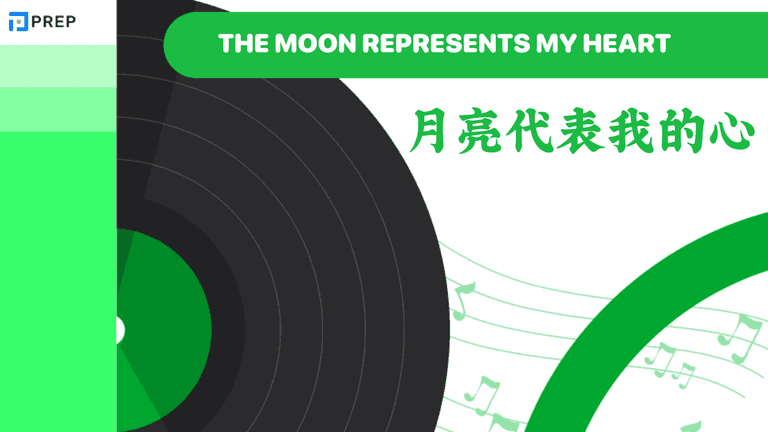Master Your Welcome in Chinese: The Definitive Guide to Phrases, Pronunciation, Usage & Cultural Nuance
Picture this: You've just received directions from a local in Beijing, or perhaps a colleague has helped you with a challenging translation. You want to express your gratitude properly, and they respond with a phrase you don't quite understand. What did they just say? How should you respond? This precise scenario highlights why understanding how to say your welcome in Chinese is essential for meaningful communication.
This comprehensive guide will equip you with every phrase, pronunciation tip, and cultural insight needed to master this fundamental aspect of Chinese politeness. Learning to say "you're welcome" appropriately in Mandarin demonstrates both linguistic competence and cultural awareness.
The Chinese language offers several ways to express "you're welcome," each carrying subtle nuances that reflect the rich cultural fabric of Chinese society. Beyond the commonly taught phrases like 不客气 (bù kèqi) and 不用谢 (bú yòng xiè), there exists a spectrum of expressions ranging from casual to formal, each appropriate for specific social contexts. These phrases reflect core Chinese cultural values like humility, mutual respect, and the importance of relationship dynamics. Unlike English, where "you're welcome" often acknowledges the service provided, Chinese expressions often downplay one's contribution, emphasizing instead the natural expectation of mutual assistance. This fundamental difference highlights why direct translation can lead to awkward or culturally inappropriate responses.
In this guide, you'll learn not just what to say, but when and how to say it. We'll cover proper pronunciation with tone guidance, explore formality levels for different situations, provide cultural context to help you understand the reasoning behind these expressions, and offer practical learning strategies to incorporate these phrases naturally into your conversations.
Let's begin by exploring the essential phrases you need to know right away – expressions that will serve you well in almost any situation where someone has thanked you. Read on to discover how mastering these responses can transform your Chinese interactions from basic exchanges to culturally nuanced conversations.
- 1. The Absolute Essentials: Immediately Usable Phrases for "You're Welcome"
- 2. Sounding Natural: Perfecting Your Pronunciation & Tones
- 3. Expanding Your Vocabulary: Beyond the Basics
- 4. Context is King: Navigating Formality & Situations
- 5. Cultural Deep Dive: Understanding 客气 (kèqi) and Chinese Politeness
- 6. Practical Learning Strategies: Memorization & Practice
- 7. Quick Reference Guide: Comparing "You're Welcome" Phrases
- 8. Fine-Tuning Your Understanding: Frequently Asked Questions & Comparisons
- 8.1. What's the real difference in daily usage between 不客气 (bù kèqi) and 不用谢 (bú yòng xiè)?
- 8.2. Is it ever considered rude not to say "you're welcome" explicitly in Chinese?
- 8.3. Which "you're welcome" phrases are most suitable specifically for business settings versus casual meetups?
- 8.4. Can 欢迎 (huānyíng) be used for "you're welcome"?
- 8.5. How does responding to a simple '谢谢 (xièxie)' differ from responding to a more emphatic '非常感谢 (fēicháng gǎnxiè)'?
- 9. Beyond the Basics: Avoiding Common Learner Mistakes & Sounding Truly Fluent

1. The Absolute Essentials: Immediately Usable Phrases for "You're Welcome"
Before diving into the nuances, let's establish the foundational expressions you can begin using immediately. Chinese offers several ways to respond to thanks, with two phrases standing out as the most versatile and widely recognized. If you're wondering how to say you're welcome in Chinese, these core expressions will serve you well in nearly any situation where someone expresses gratitude. Learning these Chinese you're welcome phrases will immediately enhance your ability to respond appropriately in conversations.
1.1. 不客气 (bù kèqi): The Universal Standard Response
不客气 reigns as the most standard, versatile expression for your welcome in Chinese. This phrase appears in textbooks, daily conversations, formal settings, and casual exchanges alike. The beauty of 不客气 lies in its universal appropriateness—it's rarely, if ever, the wrong choice when expressing you're welcome Chinese.
The literal translation reveals cultural insights: "不" means "not" and "客气" means "polite/formal/ceremonious." Together, they essentially mean "don't be polite" or "no need for such formality"—suggesting that the favor or help given doesn't require special thanks or ceremony. This perfectly encapsulates the Chinese cultural value of relationships where mutual help is expected rather than exceptional.
Characters: 不客气
Pinyin with tones: bù kèqi (4th tone - 4th tone - neutral/5th tone)
When pronouncing this phrase, pay particular attention to the falling tone of "bù" (like finishing a definitive statement) and "kè" (another falling tone), while "qi" is pronounced with a lighter, neutral tone.
This expression works seamlessly in most situations, from helping a stranger with directions to assisting a business associate with a substantial task. If you're learning how to write you're welcome in Chinese, these characters are essential to memorize first.
1.2. 不用谢 (bú yòng xiè): The Common "No Need for Thanks"
This equally common alternative offers another versatile way to say your welcome in Chinese. The literal translation—"no need (to) thank"—directly addresses the act of thanking itself. For those looking to understand Chinese for you're welcome, this is another fundamental phrase.
Characters: 不用谢
Pinyin with tones: bú yòng xiè (2nd tone - 4th tone - 4th tone)
Here we encounter an important pronunciation rule that demonstrates the complexity and precision of Mandarin tones. The character "不" (bù) normally carries a 4th tone (falling), but it changes to a 2nd tone (rising) when followed by another 4th tone like "yòng." This tone sandhi rule transforms "bù yòng xiè" into "bú yòng xiè," creating a more melodious flow.
While 不用谢 and 不客气 often function interchangeably, some native speakers perceive 不用谢 as slightly less formal, making it particularly suitable for interactions with peers and in everyday situations. Both phrases remain appropriate in most contexts, giving you flexibility without risk of social missteps. These expressions are fundamental when studying mandarin you're welcome phrases.
2. Sounding Natural: Perfecting Your Pronunciation & Tones
Pronunciation in Chinese extends far beyond mere communication—it directly impacts how polite you sound. Even with the correct phrase, improper tones can inadvertently convey indifference or even rudeness. Let's focus on perfecting these crucial elements of your welcome in Chinese.
2.1. Why Tones are Non-Negotiable for Politeness in Chinese
Chinese tones don't merely change meaning—they also affect the perceived emotional quality of your speech. Flat or incorrect tones can make polite phrases sound abrupt, insincere, or confused. For instance, saying bù (4th tone) incorrectly as bǔ (3rd tone) in 不客气 can sound hesitant rather than reassuring. Similarly, pronouncing kèqi with rising tones might sound like a question rather than a statement of reassurance.
2.2. Mastering Key Sounds: Common Hurdles for Learners
Several sounds in these phrases present challenges for English speakers learning how do you say you're welcome in Chinese. The 'q' in 客气 (kèqi) requires a position between English 'ch' and 'k,' produced with the tongue further back than for 'ch' but with lips more spread. The 'x' in 谢 (xiè) has no English equivalent—imagine saying 'sh' while smiling broadly, with the middle of your tongue raised toward the roof of your mouth.
For 不客气, focus on making 'bù' short and definitive with a falling tone, while keeping 'qi' light and neutral. For 不用谢, practice the tone change in 'bú' (rising) before the falling 'yòng,' followed by another falling tone in 'xiè.' These pronunciation details are crucial when practicing how to say you're welcome in mandarin.
2.3. Interactive Practice: Listen, Repeat, and Refine
The most effective learning approach combines listening and speaking. Start by listening carefully to native pronunciations, paying close attention to both the sounds and their tonal qualities. Then practice shadowing—repeating immediately after the speaker, mimicking not only the sounds but the rhythm and tones.
Try recording yourself and comparing with native speakers. This feedback loop accelerates improvement dramatically. Consistent practice creates muscle memory, gradually transforming conscious effort into natural speech patterns when expressing your welcome in mandarin.
3. Expanding Your Vocabulary: Beyond the Basics
While the core phrases serve most situations admirably, expanding your repertoire allows for more natural, context-appropriate responses. These additional expressions demonstrate linguistic flexibility and cultural awareness, allowing your responses to match the specific situation and relationship.
3.1. Casual & Friendly Alternatives
These phrases work well in relaxed settings where maintaining formality is unnecessary. They're excellent choices for casual instances of youre welcome in Chinese.
3.1.1. 没事 (méi shì) / 没事儿 (méi shìr)
This casual phrase translates to "it's nothing" or "no problem" and serves as a friendly, relaxed response to thanks. The northern Chinese variant adds the diminutive suffix 儿 (r), slightly modifying the pronunciation of "shì" by adding an r-colored ending.
Characters: 没事 / 没事儿
Pinyin: méi shì / méi shìr
This expression works particularly well among friends, colleagues of similar status, or in response to minor favors. It conveys a sense of ease and comfort with the relationship, suggesting that helping each other requires no formal thanks. This is an excellent choice when expressing you re welcome in Chinese to friends.
3.1.2. 没什么 (méi shénme)
Translating literally to "it's nothing really," this phrase downplays your effort or contribution, making it ideal for modest responses to gratitude.
Characters: 没什么
Pinyin: méi shénme
This phrase carries a subtle implication that the task required minimal effort or inconvenience, making it most appropriate when responding to thanks for genuinely small favors. Using it for significant help might come across as disingenuous or dismissive of the other person's gratitude.
3.2. Humble & Respectful Alternatives
These phrases highlight the value of humility and duty in Chinese culture. They're particularly important for those learning how to say you're welcome in mandarin Chinese for formal settings. The Mandarin for you're welcome in formal settings often emphasizes humility and duty, as demonstrated by these expressions.
3.2.1. 应该的 (yīnggāi de)
This phrase translates to "it's what I should do" or "it's my duty," emphasizing the sense of responsibility or obligation.
Characters: 应该的
Pinyin: yīnggāi de
This response works exceptionally well in professional contexts or when helping someone in a capacity that aligns with your role or responsibilities. It conveys both modesty and a sense of proper conduct, making it particularly appropriate when assisting elders, superiors, or customers. For business contexts, this is a key phrase for you are welcome in Chinese language.
3.2.2. 小事一桩 (xiǎo shì yī zhuāng)
This more literary expression translates to "a trivial matter" or "a small thing," elegantly minimizing your effort while acknowledging the thanks.
Characters: 小事一桩
Pinyin: xiǎo shì yī zhuāng
This phrase requires careful context assessment, as it might sound slightly affected or overly modest in some situations. It works best when the task genuinely required significant effort but you wish to graciously downplay it. Using it for truly minor assistance might seem unnecessarily formal or even sarcastic.
3.3. Other Useful Contextual Responses
These phrases address specific situations or preceding expressions of gratitude.
3.3.1. 别客气 (bié kèqi)
Similar to 不客气 but with a slightly stronger tone, this phrase means "don't be polite" or "don't mention it."
Characters: 别客气
Pinyin: bié kèqi
The imperative form (别 instead of 不) makes this slightly more insistent than 不客气, giving it an encouraging quality. It works well when someone appears overly grateful or apologetic for imposing, gently reassuring them that their gratitude or concern is unnecessary. This is an excellent alternative when expressing your welcome Chinese.
3.3.2. 不麻烦 (bù máfan)
This phrase means "not troublesome" or "no bother" and serves as a direct response to someone apologizing for the inconvenience they caused.
Characters: 不麻烦
Pinyin: bù máfan
This expression specifically addresses concerns about inconvenience, making it most appropriate as a response to phrases like 麻烦你了 (máfan nǐ le - "sorry to trouble you") rather than simple thanks. It reassures the speaker that their request caused no significant disruption or difficulty.
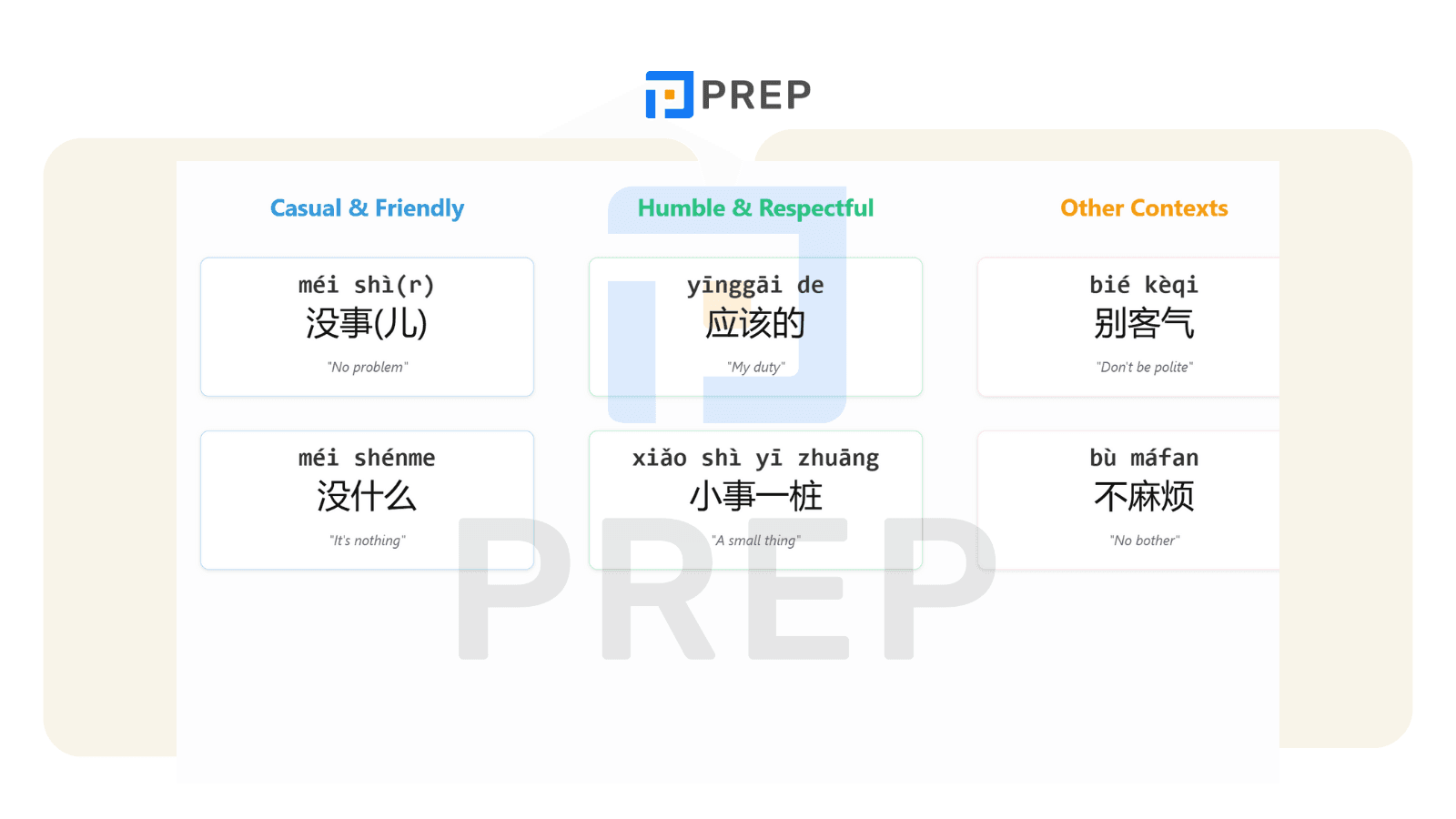
4. Context is King: Navigating Formality & Situations
Chinese communication places tremendous emphasis on appropriate levels of formality based on relationship dynamics and situational context. Understanding when to use each phrase enhances both communication effectiveness and social propriety.
4.1. Mapping Phrases to Formality Levels
The formality spectrum guides appropriate phrase selection across different relationships and environments, which is crucial for mastering mandarin you are welcome expressions:
Formal (elders, superiors, customers, formal settings): 不客气 and 应该的 serve as the most reliable choices, conveying appropriate respect without excessive familiarity. In particularly formal situations, remember to use 您 (nín) rather than 你 (nǐ) when addressing the other person.
Standard (general public, colleagues, acquaintances): 不客气 and 不用谢 work universally well, striking the right balance between politeness and natural communication.
Informal (friends, family, close peers): 没事(儿), 没什么, and casual variants of 不用谢 create the appropriate relaxed atmosphere while still acknowledging gratitude appropriately. These are excellent choices for you re welcome in mandarin among friends.
4.2. Real-World Application: Mini-Dialogue Examples
Consider these practical scenarios demonstrating contextual usage:
Giving directions to a tourist:
Tourist: 谢谢您的帮助! (Xièxie nín de bāngzhù! - Thank you for your help!)
You: 不客气,祝您玩得开心。(Bù kèqi, zhù nín wán de kāixīn. - You're welcome, hope you have a good time.)
Workplace assistance:
Colleague: 太感谢了,我自己真的解决不了这个问题。(Tài gǎnxiè le, wǒ zìjǐ zhēn de jiějué bù liǎo zhège wèntí. - Thanks so much, I really couldn't solve this problem myself.)
You: 应该的,我们是一个团队嘛。(Yīnggāi de, wǒmen shì yí gè tuánduì ma. - It's what I should do, we're a team after all.)
Service interaction:
Customer: 麻烦你了。(Máfan nǐ le. - Sorry to trouble you.)
You: 不麻烦,这是我的工作。(Bù máfan, zhè shì wǒ de gōngzuò. - No trouble at all, it's my job.)
Friend asking for a small favor:
Friend: 谢谢你帮我拿这个。(Xièxie nǐ bāng wǒ ná zhège. - Thanks for getting this for me.)
You: 没事儿,举手之劳。(Méi shìr, jǔshǒu zhī láo. - No problem, it was just a small effort.)
These examples demonstrate how to naturally incorporate thank you and your welcome in Chinese conversations.
5. Cultural Deep Dive: Understanding 客气 (kèqi) and Chinese Politeness
To truly master these expressions, we must understand the cultural foundation upon which they rest. Chinese politeness concepts differ substantially from Western norms in several key respects.
5.1. The Core Concept
The term 客气 (kèqi) itself encompasses a complex range of meanings: politeness, courtesy, formality, and ceremonious behavior. It specifically refers to the formality observed between people who aren't close—treating others as "guests" rather than intimates. When someone says 不客气, they essentially invite the other person to interact without such formal barriers, suggesting a move toward greater relational comfort.
5.2. Humility vs. Directness
Chinese politeness prioritizes humility and the minimization of one's contributions or achievements. Phrases like 没什么 (it's nothing) or 应该的 (it's my duty) reflect this cultural value, deliberately downplaying personal effort to demonstrate modesty. This contrasts with some Western responses that might acknowledge the effort ("Happy to help" or "My pleasure"), which can seem self-congratulatory in Chinese cultural contexts.
5.3. Implicit Acknowledgement
In very close relationships—family members or lifelong friends—verbal responses to thanks might be reduced or even omitted entirely. A simple nod, smile, or continued action might replace verbal acknowledgment, indicating a relationship so close that formal expressions of gratitude and response are unnecessary. However, non-verbal cues still matter tremendously, as absence of any acknowledgment might be perceived as coldness rather than intimacy.
6. Practical Learning Strategies: Memorization & Practice
Transforming this knowledge into natural communication requires systematic practice. These learning strategies will help you internalize you're welcome in Chinese mandarin expressions until they become second nature in your conversations.
6.1. Strategy 1: Utilizing Audio & Shadowing
Commit to regular listening and repetition exercises using native-speaker audio. Begin by focusing solely on pronunciation and tones for each phrase, then gradually incorporate them into progressively longer dialogue segments. This method builds both muscle memory for pronunciation and cognitive associations for contextual usage.
6.2. Strategy 2: Flashcards & Spaced Repetition (SRS)
Create flashcards that include the Chinese characters, pinyin with tone marks, and situational cues (e.g., "Responding to a colleague's thanks for significant help"). Spaced repetition systems automatically adjust review timing based on your recall performance, optimizing retention with minimal time investment.
6.3. Strategy 3: Role-Playing Scenarios
Practice with conversation partners or language exchange participants, deliberately creating situations requiring these phrases. Alternatively, conduct mental role-plays, imagining common scenarios and formulating appropriate responses. This context-based practice strengthens neural pathways connecting situations to appropriate expressions of you are welcome in mandarin.
6.4. Strategy 4: Integrating Phrases into HSK or Course Study
Connect these expressions to your broader language curriculum. HSK exam preparation often includes politeness formulas, making these phrases valuable study components. Systematically integrate them with your vocabulary acquisition strategy, regardless of whether you're following a formal curriculum or self-directed learning path.
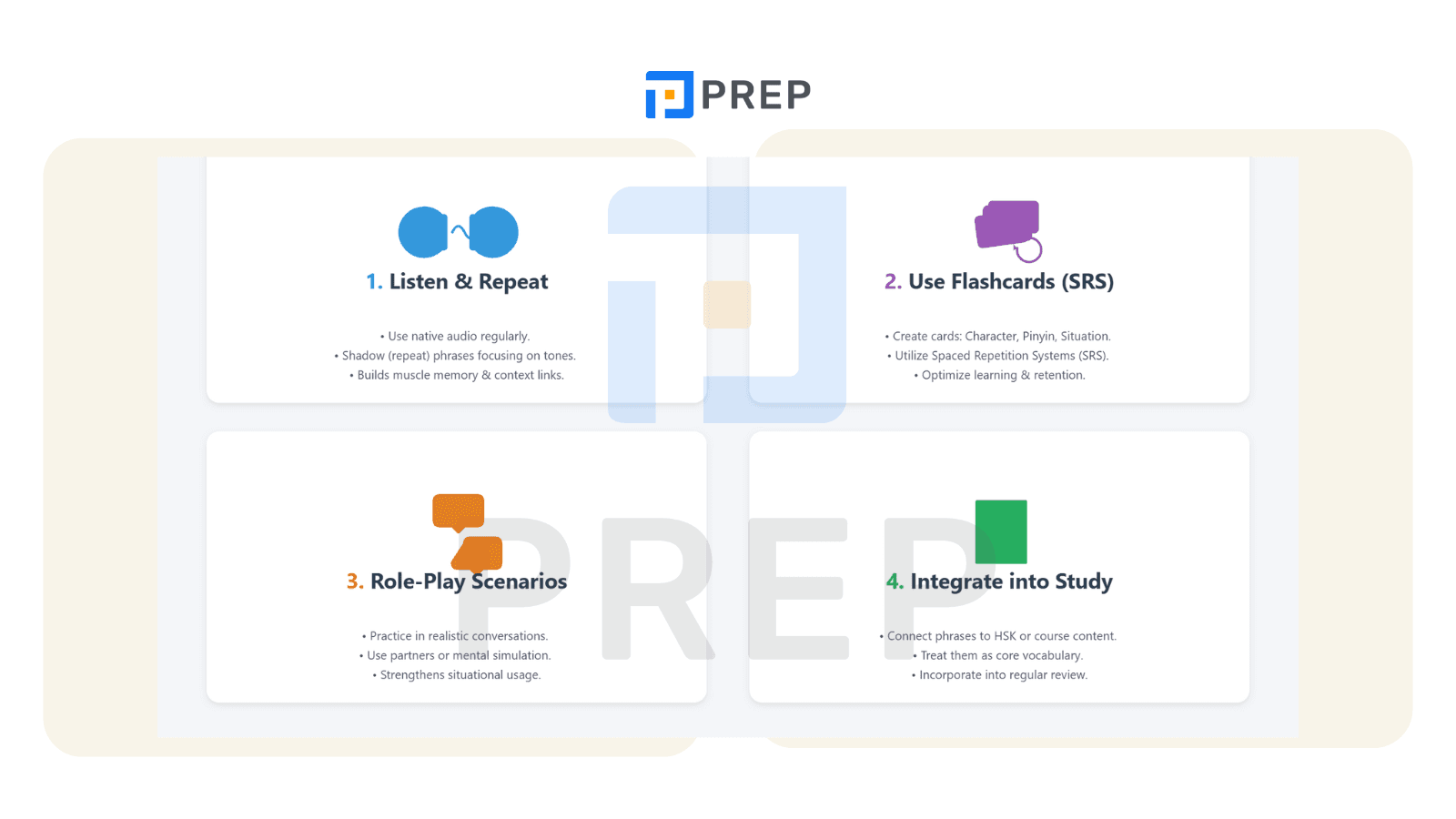
7. Quick Reference Guide: Comparing "You're Welcome" Phrases
This consolidated reference table provides an efficient review of all key expressions for rapid access during your learning journey of how to say you're welcome in Chinese.
7.1. Summary Table
|
Phrase |
Characters |
Pinyin |
Brief Meaning/Usage |
Formality Level |
|
不客气 |
不客气 |
bù kèqi |
"Don't be polite" - Universal standard response |
Medium-High |
|
不用谢 |
不用谢 |
bú yòng xiè |
"No need to thank" - Common alternative |
Medium |
|
没事(儿) |
没事(儿) |
méi shì(r) |
"It's nothing" - Casual response |
Low |
|
没什么 |
没什么 |
méi shénme |
"It's nothing really" - Downplays effort |
Low-Medium |
|
应该的 |
应该的 |
yīnggāi de |
"It's what I should do" - Emphasizes duty |
Medium-High |
|
小事一桩 |
小事一桩 |
xiǎo shì yī zhuāng |
"A trivial matter" - Literary, elegant |
Medium-High |
|
别客气 |
别客气 |
bié kèqi |
"Don't be polite" - More insistent version |
Medium |
|
不麻烦 |
不麻烦 |
bù máfan |
"Not troublesome" - Responds to apologies |
Medium |
Now that we've covered the essential expressions and their applications, let's address some specific questions that often arise for learners and explore how to avoid common mistakes that might undermine your communication efforts.
8. Fine-Tuning Your Understanding: Frequently Asked Questions & Comparisons
These targeted questions address specific points of confusion that often arise when learning to respond to thanks in Chinese.
8.1. What's the real difference in daily usage between 不客气 (bù kèqi) and 不用谢 (bú yòng xiè)?
While these phrases function similarly in most contexts, subtle differences emerge in actual usage patterns. Native speakers often perceive 不客气 as slightly more formal or standard, making it marginally more appropriate in professional environments or with elders. Meanwhile, 不用谢 often feels more natural in casual, peer-level interactions. However, these distinctions remain slight—both phrases work effectively across most situations, and native speakers use them interchangeably without conscious distinction in many contexts.
8.2. Is it ever considered rude not to say "you're welcome" explicitly in Chinese?
The answer depends entirely on relationship context. Between very close friends or family members, verbal responses often become optional, with non-verbal acknowledgment (nodding, smiling) sufficing. However, in most other interactions—particularly with acquaintances, colleagues, or strangers—failing to respond to thanks might be perceived as dismissive or disrespectful. When in doubt, offering a verbal response demonstrates conscientiousness and social awareness.
8.3. Which "you're welcome" phrases are most suitable specifically for business settings versus casual meetups?
Business environments generally benefit from more formal, duty-acknowledging phrases. 不客气 serves as the safest universal option, while 应该的 works particularly well when the assistance falls within your professional responsibilities. For client-facing roles, 不麻烦 appropriately addresses concerns about imposing on your time. In casual meetups, 没事(儿), 没什么, and relaxed delivery of 不用谢 create the right informal atmosphere while maintaining politeness.
8.4. Can 欢迎 (huānyíng) be used for "you're welcome"?
This represents a common learner confusion based on English overlap. Despite translating to "welcome" in English, 欢迎 functions exclusively as a greeting or invitation (e.g., "Welcome to China"), never as a response to thanks. Using 欢迎 instead of 不客气 or similar phrases would create significant confusion, suggesting you're welcoming someone to a place rather than acknowledging their gratitude. This distinction highlights why direct translation between languages often leads to communication errors.
8.5. How does responding to a simple '谢谢 (xièxie)' differ from responding to a more emphatic '非常感谢 (fēicháng gǎnxiè)'?
While standard responses work for both, stronger expressions of gratitude often benefit from slightly more substantive acknowledgment. When someone offers an emphatic "thank you very much" (非常感谢), matching their energy level can feel more appropriate—perhaps using 不客气 with warmer intonation, or adding a reassuring phrase like 这没什么 (zhè méi shénme - "this is nothing") or 随时可以帮忙 (suíshí kěyǐ bāngmáng - "happy to help anytime"). The principle resembles matching someone's emotional tone in conversation—responding to heightened emphasis with corresponding acknowledgment.
9. Beyond the Basics: Avoiding Common Learner Mistakes & Sounding Truly Fluent
As you advance in your Chinese journey, avoiding these common pitfalls will help you communicate more naturally and effectively when using your welcome in Chinese expressions.
9.1. Pitfall 1: Over-reliance on a Single Phrase
Many learners cling to the first your welcome in Chinese phrase they learn, using it in every situation regardless of context. This creates an artificial quality to communication—like someone who responds with the identical "you're welcome" to every thanks in English rather than varying with "no problem," "anytime," "happy to help," etc. Gradually integrate multiple phrases into your active vocabulary, choosing based on the specific situation and relationship.
9.2. Pitfall 2: Incorrect Tone Usage Leading to Misunderstanding
Tonal errors can transform polite phrases into confusing or even offensive statements. The tone change in 不用谢 (bú yòng xiè) proves particularly challenging, with many learners incorrectly maintaining the fourth tone on 不 (bù). Regular pronunciation practice with feedback—whether from teachers, language partners, or audio comparison—remains essential for accurate communication when expressing you are welcome in Chinese.
9.3. Pitfall 3: Mismatched Formality Levels
Using overly casual expressions like 没事儿 in formal settings or unnecessarily formal phrases like 应该的 with close friends can create social awkwardness. Consider both relationship dynamic and environmental context when selecting appropriate responses. When uncertain, defaulting to middle-formality phrases like 不客气 or 不用谢 provides the safest approach.
9.4. Moving Towards Fluency: Integrating Responses Naturally
True mastery comes when these phrases emerge naturally without conscious translation. This requires consistent practice in authentic contexts—whether through conversation partners, language exchange, or immersion experiences. Each successful exchange builds confidence and automaticity, gradually transforming these expressions from foreign vocabulary into natural communication tools. Remember that mastering how do you say you're welcome in mandarin represents a crucial milestone in your journey toward Mandarin fluency.
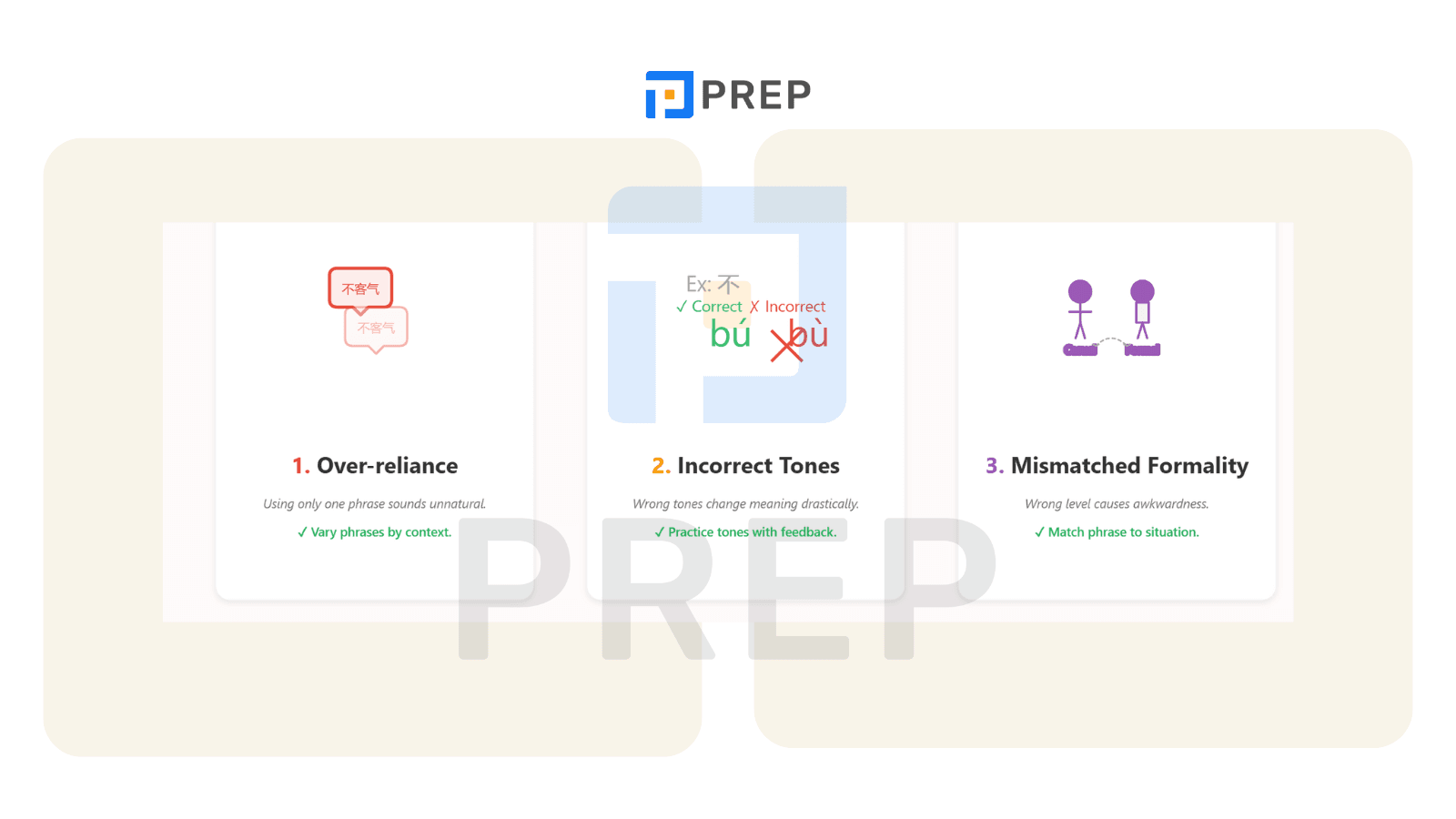
By incorporating these phrases about your welcome in Chinese into your active vocabulary, understanding their cultural context, and selecting them appropriately based on situation, you'll demonstrate both linguistic competence and cultural sensitivity—essential components of effective communication in Chinese.

Hi I'm Chloe, and I am currently serving as an Product Content Administrator at Prep Education. With over five years of experience in independent online IELTS study and exam preparation, I am confident in my ability to support learners in achieving their highest possible scores.
Comment
Premium content
View allPersonalized roadmap
Most read




